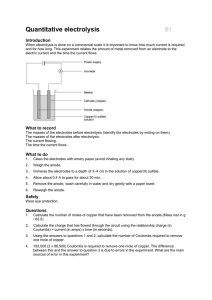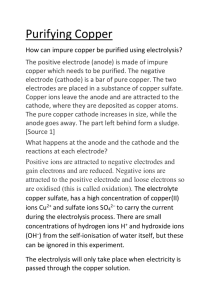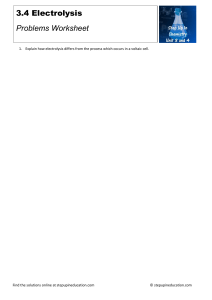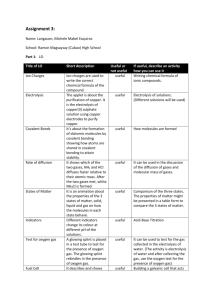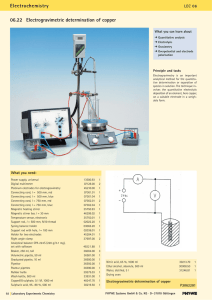81. Quantitative electrolysis
advertisement
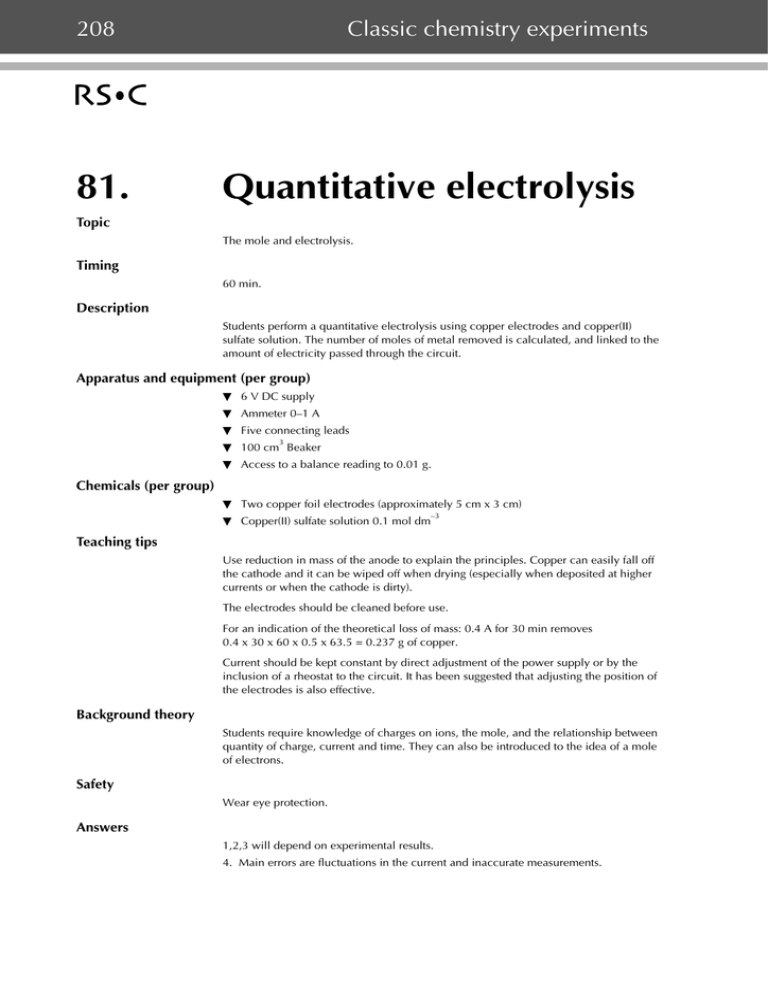
208 81. Classic chemistry experiments Quantitative electrolysis Topic The mole and electrolysis. Timing 60 min. Description Students perform a quantitative electrolysis using copper electrodes and copper(II) sulfate solution. The number of moles of metal removed is calculated, and linked to the amount of electricity passed through the circuit. Apparatus and equipment (per group) ▼ 6 V DC supply ▼ Ammeter 0–1 A ▼ Five connecting leads 3 ▼ 100 cm Beaker ▼ Access to a balance reading to 0.01 g. Chemicals (per group) ▼ Two copper foil electrodes (approximately 5 cm x 3 cm) –3 ▼ Copper(II) sulfate solution 0.1 mol dm Teaching tips Use reduction in mass of the anode to explain the principles. Copper can easily fall off the cathode and it can be wiped off when drying (especially when deposited at higher currents or when the cathode is dirty). The electrodes should be cleaned before use. For an indication of the theoretical loss of mass: 0.4 A for 30 min removes 0.4 x 30 x 60 x 0.5 x 63.5 = 0.237 g of copper. Current should be kept constant by direct adjustment of the power supply or by the inclusion of a rheostat to the circuit. It has been suggested that adjusting the position of the electrodes is also effective. Background theory Students require knowledge of charges on ions, the mole, and the relationship between quantity of charge, current and time. They can also be introduced to the idea of a mole of electrons. Safety Wear eye protection. Answers 1,2,3 will depend on experimental results. 4. Main errors are fluctuations in the current and inaccurate measurements. Classic chemistry experiments 209 Quantitative electrolysis Introduction When electrolysis is done on a commercial scale it is important to know how much current is required and for how long. This experiment relates the amount of metal removed from an electrode to the electric current and the time the current flows. Power supply A Ammeter Beaker Cathode (copper) Anode (copper) Copper(II) sulfate solution What to record ▼ The masses of the electrodes before electrolysis (identify the electrodes by writing on them). ▼ The masses of the electrodes after electrolysis. ▼ The current flowing. ▼ The time the current flows. What to do 1. Clean the electrodes with emery paper (avoid inhaling any dust). 2. Weigh the anode. 3. Immerse the electrodes to a depth of 3–4 cm in the solution of copper(II) sulfate. 4. Allow about 0.4 A to pass for about 30 min. 5. Remove the anode, wash carefully in water and dry gently with a paper towel. 6. Reweigh the anode. Safety Wear eye protection. Questions 1. Calculate the number of moles of copper that have been removed from the anode.(Mass lost in g / 63.5) 2. Calculate the charge that has flowed through the circuit using the relationship charge (in Coulombs) = current (in amps) x time (in seconds). 3. Using the answers to questions 1 and 2, calculate the number of Coulombs required to remove one mole of copper. 4. 193,000 (2 x 96,500) Coulombs is required to remove one mole of copper. The difference between this and the answer to question 3 is due to errors in the experiment. What are the main sources of error in this experiment?
